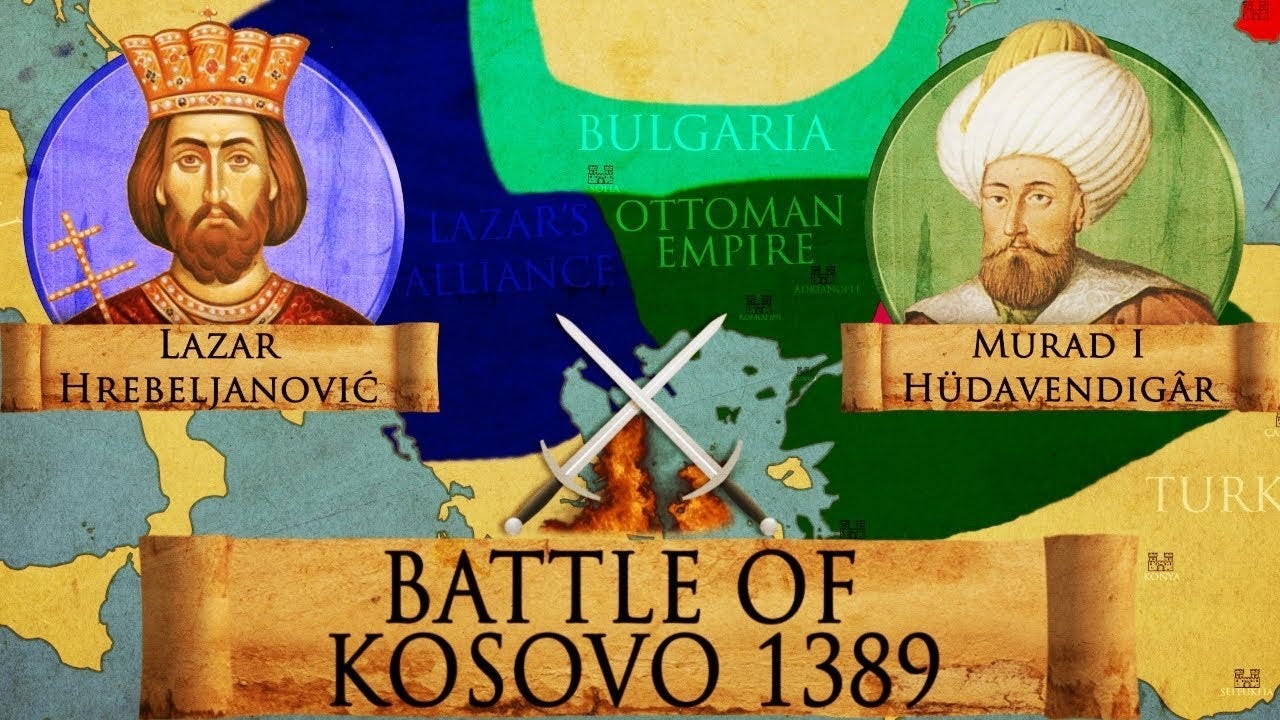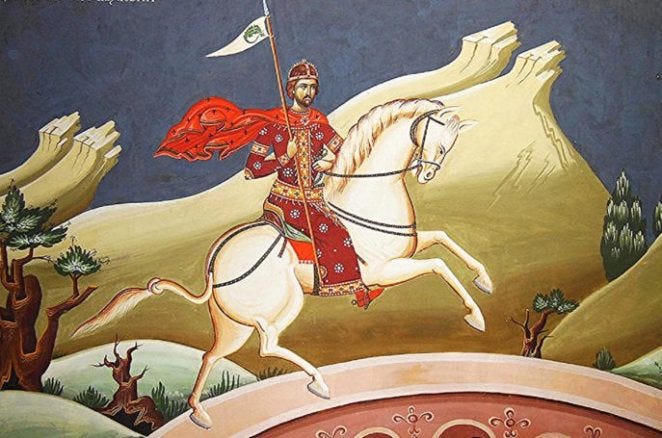Streaming video platforms like Netflix and Hulu have many popular shows about royal families from history (and fictional historical periods): Game of Thrones, The Tudors, Versailles, The Last Kingdom, Medici, Troy, The Borgias, and many more. These shows present a struggle for power, complex story lines, ambitious characters, violence, deceit, love, betrayal, and treachery.

While studying medieval Balkan history, I learned that the Lazarevic Serbian royal family also has a set of events and characters that can compare to any popular historical drama.
Prince Lazar
Prince Lazar was the ruler of Serbia around 1370-1389. Before this time, Serbia had a large empire that included Macedonia and Kosovo. Constant fighting among Serbian rulers left the kingdom weak, and the Hungarian and Ottoman empires took over some of this territory. Prince Lazar came to power by defeating other Serbian nobles, and he eventually gained the support of the Orthodox Church. His wanted to “restore” the Kingdom of Serbia, and eventually his “Moravian Serbia” controlled a large territory.

In 1389, Prince Lazar led a united Serbian army against the larger Ottoman Empire. The Battle of Kosovo resulted in a disastrous draw - neither side had a clear victory. Both Prince Lazar of Serbia and Sultan Murad of the Ottoman Empire lost their lives, and both armies had many dead soldiers. Because of this loss, Prince Lazar is remembered as a martyr and a saint, who gave his life for his country and for his religion.
After Lazar
After Lazar’s death, Serbia became an ally of the Ottoman Empire. Lazar’s wife Princess Milica became temporary ruler, and the lives of their seven children continued to influence the events of the medieval Balkan region.
Stefan Lazarevic - Lazar’s oldest son - inherited the kingdom at age 18 and ruled until his death in 1427. He became an ally of the Ottoman and Hungarian empires, and he maintained control of the kingdom (through alliances and military support) even though we was under-age and surrounded by Serbian and Bosnian nobles who could have defeated him. Stefan expanded the Kingdom of Serbia to include Belgrade, he became one of the most powerful leaders in the Balkans, and he is now considered one of the most important rulers of Serbia. He brought peace and stability, and he improved Serbia’s economic status in Europe. He also promoted the arts and encouraged the development of a Serbian culture.

Vuk Lazarevic - Lazar’s younger son and Stefan’s brother. As a teenager and young adult, Vuk was a military leader alongside his brother Stefan in the Ottoman Empire. Over time, Vuk became a strong military leader himself, and he ruled a portion of the Serbian kingdom. Vuk continually fought against his brother for greater power, and he partnered with Ottoman leaders who could help him gain greater control. In 1410, opposing Ottoman forces caught Vuk and executed him.
Mara - Lazar’s oldest daughter and Stefan’s sister - married Serbian nobleman Vuk Brankovic. Brankovic ruled the southern part of the Serbian Kingdom, which included Macedonia, Kosovo, and Montenegro. Brankovic was a military leader at the Battle of Kosovo, and he and his army survived. Because of this, many Serbians at the time believed that Brankovic had betrayed Prince Lazar and had secretly defected to the Ottoman side. However, Brankovic refused to join the Ottoman Empire after the Battle of Kosovo, and he continued to fight against the Ottomans. In 1395, the Ottoman Empire took over Brankovic’s kingdom (and gave it to Stefan) - he was imprisoned and he died in jail. Mara remained close with her brother Stefan, and in 1427 her son Durad was appointed the next ruler of Serbia by Stefan (who had no children of his own).
Dragana - Lazar’s daughter and Stefan’s sister. Not much is known about Dragana. She married a Bulgarian ruler (his second wife) and died in 1395 at age 24.
Teodora - Lazar’s daughter and Stefan’s sister. Not much is known about Teodara either. She married a Hungarian nobleman and died in 1405, at around age 30.
Jelena - Lazar’s daughter and Stefan’s sister. Jelena was a powerful female political figure in Serbia and Bosnia, her family line helped establish Herzegovina, and she was also a writer. Jelena first married “the Lord of Zeta,” ruler of the Ulqin area. When he died, Jelena served as ruler for her under-aged son. During this time, Jelena helped support her brother Stefan, and she opposed the Venetian empire across the Adriatic Sea by leading a 10-year war against them. In 1411, Jelena married “the Grand Duke of Bosnia,” who divorced his first wife so he could marry Jelena and become more closely allied with Stefan. The marriage also provided safety for Jelena’s son. In 1420, the Grand Duke became the most powerful person in Bosnia, and he remained in power until 1435. Later on, Jelena’s grand-daughter became “Queen Catherine of Bosnia.” Today, Montenegro sponsors the Jelena Balsic Literature Award, which is named after her.

Olivera - Lazar’s youngest daughter and Stefan’s sister - married Ottoman Sultan Bayezid I in 1390 as part of the peace treaty after the Battle of Kosovo. She was the Sultan’s favorite wife (he had four), and she was greatly admired because she did not convert to Islam and because she had political influence over the Sultan. In 1402, the Sultan and Olivera were captured by the Mongul conqueror Timur. When the Sultan died in captivity, Timur released Olivera, and she lived with her brother Stefan in Serbia and later with her sister Jelena in Bosnia. Olivera’s imprisonment and release became well-known throughout the Balkans, and Christopher Marlowe dramatized the story in his famous 1587 play Tamburlaine (Marlowe’s character Zabina is based on Olivera, and her husband Bajazeth is imprisoned in a cage).

Thank you for reading my newsletter. I enjoy learning about history, culture, and literature. If you like these topics too, I’ll continue to write more. You can find my previous newsletters on the archive.


